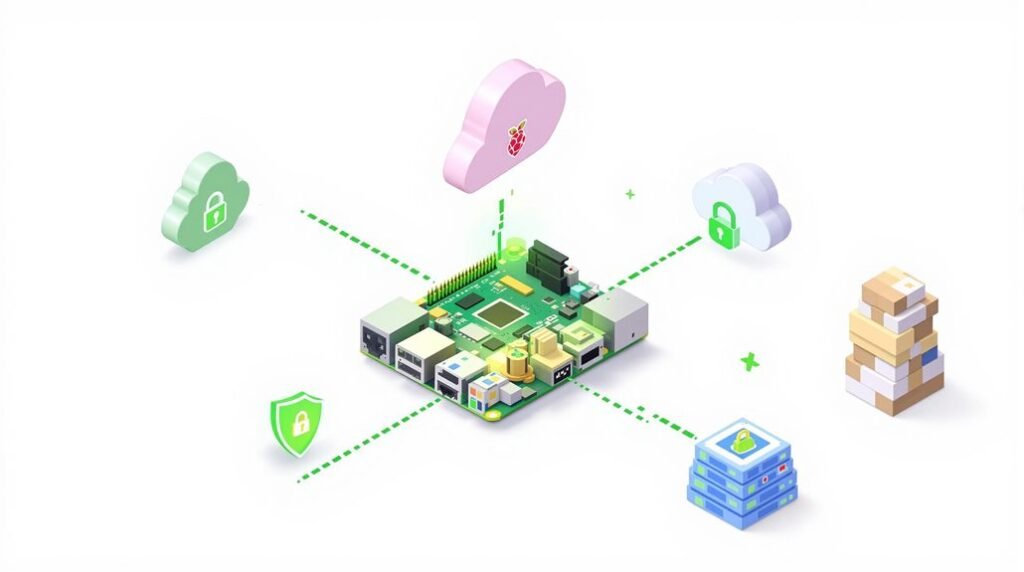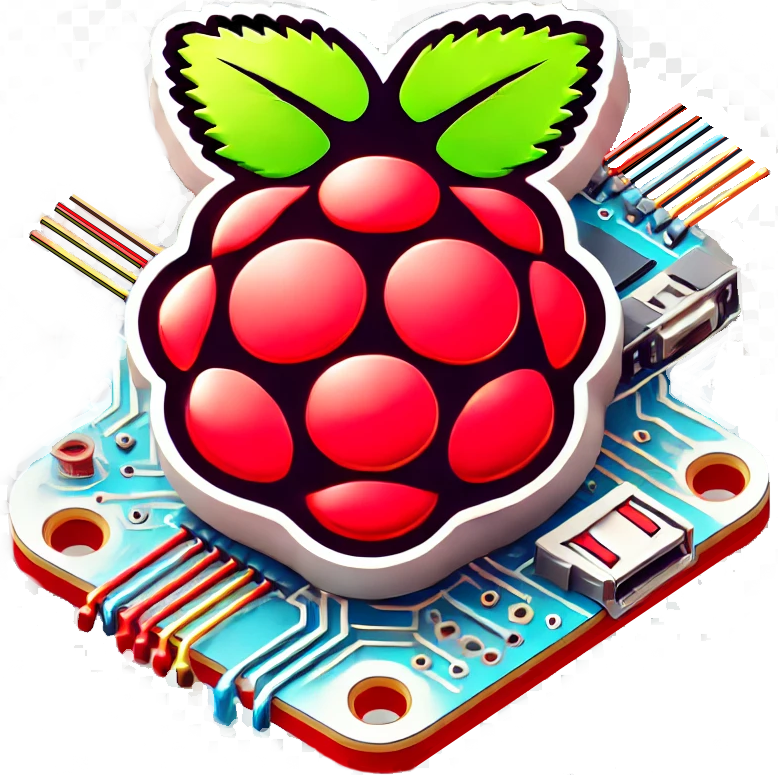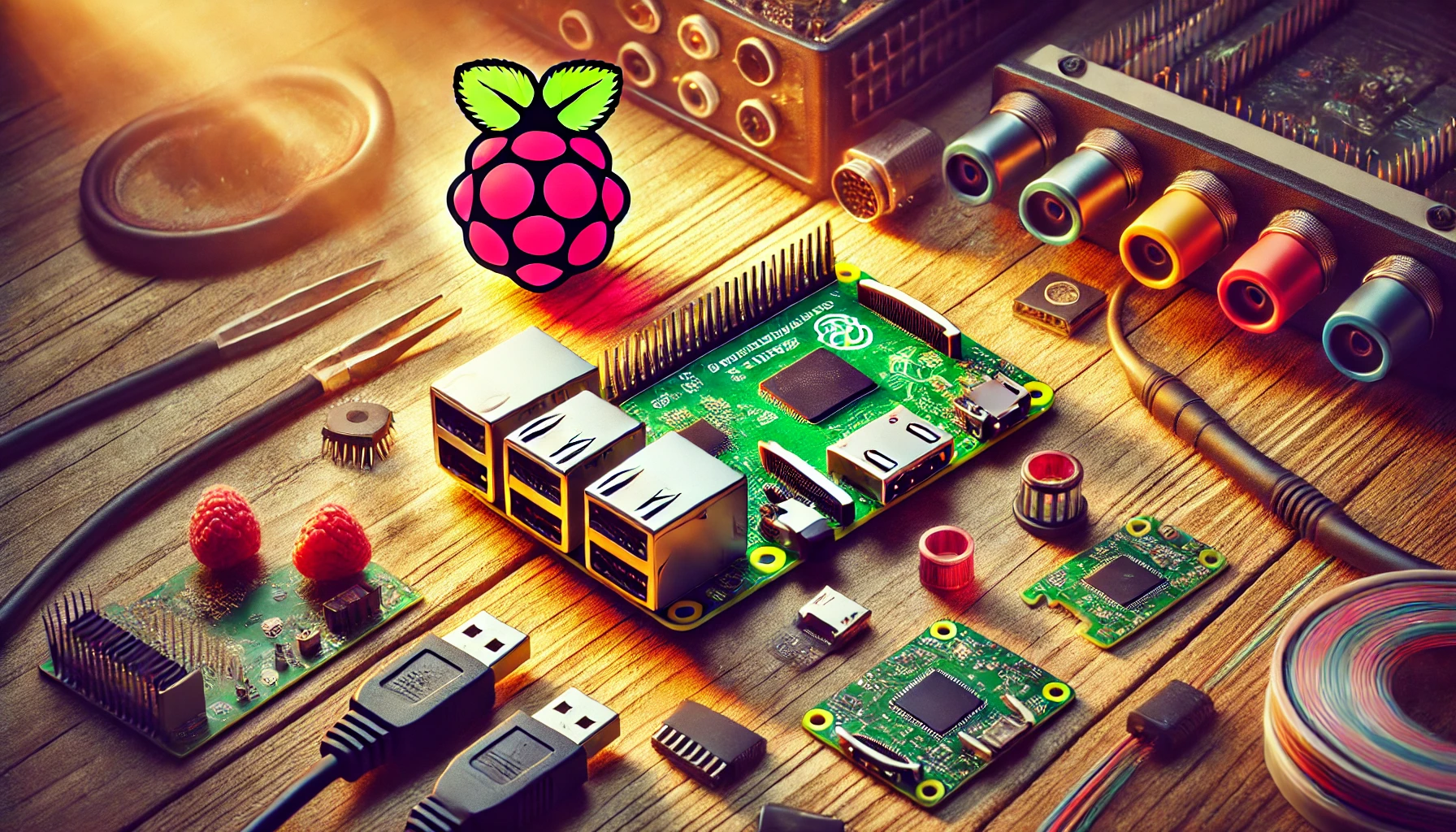Introduction
Setting up a Minecraft server on a Raspberry Pi is an affordable and efficient way to host your own multiplayer world, especially with the flexibility of the Raspberry Pi 4 or Raspberry Pi 3 models. By configuring a dedicated server, you’ll have complete control over the gameplay experience, including game modes, server settings, and player management options.
With this setup, you can transform your Raspberry Pi into a powerful gaming hub for friends to join, crafting and building within the world you design. The requirements are modest, typically a Raspberry Pi 4 with at least 4GB of RAM for smoother performance, a stable Ethernet connection, and a MicroSD card with enough space for server files and backups.
Throughout this guide, you’ll learn how to install and configure the necessary software, set up network configurations, optimize for performance, and secure your Minecraft server on the Raspberry Pi, creating a seamless and customizable multiplayer experience.
Key Takeaways
Preparing Your Raspberry Pi for the Server
To get started with a Minecraft server on a Raspberry Pi, it’s essential to prepare both the hardware and software setup. This section will guide you through gathering components, installing Raspberry Pi OS, and configuring your device for optimal performance.
Hardware Components
- Raspberry Pi 4: For best performance, use a Raspberry Pi 4 with at least 4GB of RAM. Although a Raspberry Pi 3 can work, it may experience lag with multiple players.
- MicroSD Card (32GB or larger): This card will store the OS and server files. Class 10 cards with high read/write speeds are recommended for better performance.
- Ethernet Cable: Connecting the Raspberry Pi to your router with Ethernet ensures a more stable and faster connection for multiplayer.
- Power Supply: Use an official Raspberry Pi power supply to maintain stability.
- Cooling Options: Due to the resource demands of a Minecraft server, consider a case with a heat sink or cooling fan to manage the Raspberry Pi’s temperature.
Installing Raspberry Pi OS
- Download Raspberry Pi OS Lite: The Lite version is recommended for a headless server (no GUI) as it reduces resource consumption.
- You can download Raspberry Pi OS from the Raspberry Pi website.
- Flash the OS to the MicroSD Card: Use a tool like Raspberry Pi Imager or Balena Etcher to write the OS image to your MicroSD card.
- Insert the MicroSD Card: Place the card into the Raspberry Pi’s MicroSD slot, and connect the power supply.
Initial Setup and Configuration
SSH Access: Connect to the Raspberry Pi using SSH for easy remote management.
First, enable SSH by adding an empty file named ssh (without any extension) to the MicroSD card’s root directory before booting.
System Update: Once logged in, update and upgrade the system packages.
sudo apt update && sudo apt upgrade -yBasic Configuration with raspi-config: Run the configuration tool to make essential adjustments.
sudo raspi-configExpand the filesystem for maximum storage usage.
Set up memory split (if applicable) and allocate most resources to CPU rather than GPU.
Enable SSH (if not already enabled) for remote access.
Installing Java on Raspberry Pi
The Minecraft server requires Java to run, as it’s built on Java’s platform. Installing the correct version of Java ensures smooth server performance on your Raspberry Pi.
Why Java is Essential for Minecraft
Minecraft servers rely on Java because the game itself is developed in this language. Java provides the necessary runtime environment for Minecraft’s code, making it a key component in any Minecraft server setup.
Installing OpenJDK on Raspberry Pi
- Install OpenJDK: For Minecraft servers, OpenJDK 17 or higher is recommended due to recent updates and security improvements. Install it by running:
sudo apt install openjdk-17-jdk -y- Verify the Installation: Once installed, confirm that Java is correctly set up by checking the version.
java -versionThis command should output the installed Java version, indicating that Java is ready to use.
Troubleshooting Java Installation
If there are any issues during installation or if an incompatible Java version is installed, use the following steps:
- Remove Previous Java Versions: In case of conflicts, remove outdated Java versions by running:
sudo apt remove --purge openjdk-*- Reinstall OpenJDK: Re-run the
sudo apt install openjdk-17-jdk -ycommand to ensure the correct version is in place.
Downloading and Configuring the Minecraft Server
With Java installed, you’re ready to download the Minecraft server JAR file and configure the server settings on your Raspberry Pi. This section will guide you through setting up the server software, adjusting initial configurations, and preparing your Minecraft world for multiplayer access.
Step 1: Downloading the Minecraft Server JAR File
Create a Directory for the Server: Start by creating a dedicated folder to store Minecraft server files.
mkdir ~/minecraft && cd ~/minecraftDownload the Server JAR File: Visit the official Minecraft server download page to obtain the latest version of the server JAR file.
Use the wget command to download directly to your Raspberry Pi:
wget https://launcher.mojang.com/v1/objects/<server_version>.jar -O minecraft_server.jarReplace <server_version> with the specific version URL available on the download page.
Step 2: Running the Server for Initial Setup
Start the Server: Run the server for the first time to generate essential configuration files.
java -Xms512M -Xmx1024M -jar minecraft_server.jar nogui-Xms and -Xmx set the initial and maximum memory allocation. Adjust these values based on your Raspberry Pi’s RAM (1024M or 1GB is typical for Raspberry Pi 4).
The server will create a few files, including eula.txt and server.properties, before shutting down automatically.
Accept the EULA: Open the eula.txt file and change eula=false to eula=true to agree to the Minecraft End User License Agreement.bashCopy codenano eula.txt
Save and exit by pressing CTRL + X, then Y, and ENTER.
Step 3: Configuring Server Properties
- Open the server.properties File: This file allows you to customize the Minecraft server settings.
nano server.properties2. Customize Key Settings:
gamemode: Set to survival, creative, or adventure based on the desired gameplay.
max-players: Set the number of players that can join your server, which impacts resource usage.
difficulty: Choose peaceful, easy, normal, or hard.
view-distance: Set the chunk loading distance to balance performance (a lower value like 6 can reduce lag on the Raspberry Pi).
level-seed: Optionally specify a seed for the Minecraft world generation.
Save Changes: After customizing the settings, save the file and exit.
With the server properties configured, you’re now ready to set up the network and port forwarding to allow multiplayer connections.
Setting Up Network and Port Forwarding
To allow players to connect to your Minecraft server over the internet, you need to set up your Raspberry Pi on a static IP address and configure port forwarding on your router. This ensures a stable and accessible server connection for both local and remote players.
Step 1: Assigning a Static IP Address
A static IP address prevents the Raspberry Pi’s IP from changing on your network, making it easier to set up and maintain port forwarding.
Edit the DHCP Configuration: Open the DHCP client configuration file.bashCopy codesudo nano /etc/dhcpcd.conf
Set a Static IP Address: Scroll to the end of the file and add the following lines, replacing 192.168.1.XX with your preferred IP within your network’s range and router_ip with your router’s IP address.
eth0 static ip_address=192.168.1.XX/24 static routers=router_ip static domain_name_servers=router_ipeth0 specifies the Ethernet interface. If using Wi-Fi, replace eth0 with wlan0.
This assigns the Pi a static IP on your local network.
Restart Networking: Apply the changes by restarting the Raspberry Pi or using the following command.bashCopy codesudo reboot
Step 2: Configuring Port Forwarding on Your Router
Port forwarding allows external devices to connect to your Raspberry Pi’s Minecraft server. Most Minecraft servers use port 25565 for connections.
- Access Your Router Settings: Log in to your router’s settings page. This is typically done by entering your router’s IP address in a web browser (e.g.,
192.168.1.1or192.168.0.1). - Locate Port Forwarding: Find the port forwarding section, which may be under Advanced or Firewall settings, depending on the router.
- Set Up Port Forwarding:
- IP Address: Enter your Raspberry Pi’s static IP address (e.g.,
192.168.1.XX). - Port Range: Set the start and end ports to
25565. - Protocol: Choose TCP (or TCP/UDP if required by your router).
- Enable the port forwarding rule and save changes.
- IP Address: Enter your Raspberry Pi’s static IP address (e.g.,
- Test the Port: Use an online tool like canyouseeme.org to check if port 25565 is open. Enter the port number, and if the test is successful, your server is accessible over the internet.
Step 3: Testing Local and External Connections
- Local Network Test: From a computer on the same network, open Minecraft and go to Multiplayer > Add Server. Enter the Raspberry Pi’s local IP address (e.g.,
192.168.1.XX), and connect to the server to verify it’s working. - External Access Test: For remote players, use your public IP address (available from sites like
whatismyip.com) in the Minecraft server settings to allow connections from outside your local network.
With port forwarding enabled, your Minecraft server is now accessible for multiplayer gameplay.
Allocating Resources and Optimizing Performance

Running a Minecraft server on a Raspberry Pi requires careful resource management to ensure smooth gameplay. Optimizing memory allocation, server settings, and plugins can help the server run more efficiently, especially for multiplayer sessions.
Step 1: Configuring Memory Allocation
The Java runtime allows you to specify the amount of RAM allocated to the Minecraft server, which is essential for maintaining performance on a Raspberry Pi.
Edit the Server Launch Command: Adjust the memory allocation parameters when starting the server:
java -Xms512M -Xmx1024M -jar minecraft_server.jar nogui-Xms sets the initial memory (e.g., 512M).
-Xmx sets the maximum memory (e.g., 1024M).
For a Raspberry Pi 4 with 4GB of RAM, setting -Xmx to 1024M (1GB) is recommended to leave enough resources for system processes.
Step 2: Adjusting Server Properties for Performance
Some settings in server.properties can reduce the server load, optimizing performance without affecting gameplay quality.
- Reduce View Distance: Lowering view distance limits the number of chunks rendered, reducing CPU usage.
- Set
view-distance=6for a moderate setting that balances visibility with performance.
- Set
- Set Entity Activation Range: This limits the distance at which entities (e.g., mobs) are active, reducing server load.
- Add this setting in
server.propertiesif supported by your server type (e.g.,entity-activation-range=16).
- Add this setting in
- Optimize Tick Rate: Minecraft’s tick rate impacts updates and physics calculations.
- Adjust settings like
max-tick-timein theserver.propertiesfile to improve tick management.
- Adjust settings like
Step 3: Using Plugins for Optimization
For better performance, consider using a server type like PaperMC or Spigot, which provides additional options for optimizing Minecraft servers. They also support plugins that help manage server resources more efficiently.
- Install PaperMC: PaperMC is a high-performance fork of Spigot with enhanced optimizations.
- Download the PaperMC JAR file from the PaperMC website.
- Replace the
minecraft_server.jarwith the downloaded Paper JAR, renaming it asminecraft_server.jarfor consistency.
- Add Optimization Plugins: Some plugins help reduce server load by managing entities, chunks, and resources.
- LaggRemover: Reduces unnecessary entities and optimizes memory usage.
- ClearLag: Clears excessive entities, improves memory management, and provides performance monitoring.
- EssentialsX: Manages server commands efficiently, reducing load from frequent command use.
Step 4: Monitoring Resource Usage
To keep your Minecraft server running smoothly, monitor the Raspberry Pi’s CPU, RAM, and network usage. This helps identify any bottlenecks or excessive resource consumption.
Check System Performance: Use tools like htop and free to monitor resource usage.
htop # For real-time CPU and RAM monitoring free -h # For a summary of available memory
Monitor Disk Usage: Check available storage to prevent crashes due to lack of space.bashCopy codedf -h
By managing memory allocation, configuring server properties, and using plugins, you can optimize your Minecraft server to run efficiently on a Raspberry Pi.
Enhancing Security and Setting Permissions
Securing your Minecraft server is essential, especially when it’s accessible over the internet. Configuring user permissions and securing access can help prevent unauthorized entry and ensure a safe gaming environment for players.
Step 1: Securing SSH Access
When your Raspberry Pi is connected to the internet, it’s critical to secure SSH (Secure Shell) to prevent unauthorized access.
- Set Up SSH Key Authentication: Instead of relying on a password, you can use SSH key pairs for a more secure login.
Generate an SSH key on your local machine:
ssh-keygen -t rsa -b 4096Copy the public key to your Raspberry Pi:
ssh-copy-id pi@raspberry_pi_ip- Disable Password Authentication: After setting up SSH key authentication, disable password login.
Edit the SSH configuration file:
sudo nano /etc/ssh/sshd_configSet PasswordAuthentication to no and PermitRootLogin to no.
- Restart SSH:
sudo systemctl restart sshStep 2: Configuring Server Permissions
Controlling who has access to specific server commands is crucial for managing the server effectively.
- Enable a Whitelist: A whitelist restricts access to only approved players.
In server.properties, set white-list=true.
Add players to the whitelist using the command:
whitelist add player_name- Manage Operator Permissions: Operators (OPs) have elevated permissions on the server. Granting OP status should be limited to trusted individuals.
Use the /op command to add a player as an operator:
op player_nameTo remove OP status, use:
deop player_nameStep 3: Configuring Firewall Rules
Using a firewall on your Raspberry Pi helps control traffic and limit access to the Minecraft server port (25565) from only specific IP addresses if needed.
Install UFW (Uncomplicated Firewall):
sudo apt install ufw -yAllow Minecraft Port: Enable only the Minecraft server port (25565) for incoming connections.
sudo ufw allow 25565/tcpEnable the Firewall:
sudo ufw enableConfirm the rules with:
sudo ufw statusStep 4: Regular Backups and Security Updates
Keeping your system and server files updated is essential for security and stability.
- Schedule Regular System Updates: Periodically update your system to patch security vulnerabilities.
sudo apt update && sudo apt upgrade -y- Automate Backups: Create scheduled backups of the server world and configurations to prevent data loss.
Use cron to automate backups. Open the cron editor:
crontab -eAdd a cron job to back up your Minecraft world every day at 3 AM:
0 3 * * * tar -czf ~/minecraft/backups/world-$(date +\%Y-\%m-\%d).tar.gz ~/minecraft/worldBy enhancing security through SSH configuration, permissions management, firewall setup, and regular backups, you can maintain a safe and secure environment on your Minecraft server.
Automating and Maintaining Your Minecraft Server

To keep your Minecraft server running smoothly, it’s important to automate routine tasks like backups, updates, and restarts. This section covers setting up automatic maintenance processes to ensure a reliable gaming experience for players.
Step 1: Automating Backups
Regular backups prevent data loss in case of crashes or errors, allowing you to restore the server to a previous state.
Create a Backup Script: Write a simple script to back up your Minecraft world files.
nano ~/minecraft/backup.shAdd the following lines to the script:
#!/bin/bash tar -czf ~/minecraft/backups/world-$(date +%Y-%m-%d_%H-%M-%S).tar.gz ~/minecraft/worldSave and exit (CTRL + X, then Y, then ENTER).
Make the Script Executable:
chmod +x ~/minecraft/backup.shSchedule Backups with Cron: Open the cron editor and add a job to back up the world daily at 3 AM.
crontab -eAdd the following line:plaintextCopy code0 3 * * * ~/minecraft/backup.sh
Step 2: Automating Server Startup on Boot
Configuring your Minecraft server to start automatically after a reboot ensures it’s always available for players, even after power outages or maintenance reboots.
Create a Systemd Service File: This file allows the server to start automatically when the Raspberry Pi boots.
sudo nano /etc/systemd/system/minecraft.serviceAdd the following configuration:
[Unit]
Description=Minecraft Server
After=network.target
[Service]
User=pi
WorkingDirectory=/home/pi/minecraft
ExecStart=/usr/bin/java -Xms512M -Xmx1024M -jar minecraft_server.jar nogui
Restart=on-failure
[Install]
WantedBy=multi-user.targetAdjust -Xms and -Xmx based on your Raspberry Pi’s memory.
Enable the Service:
sudo systemctl enable minecraftStart the Server:
sudo systemctl start minecraftCheck the Server Status:
sudo systemctl status minecraftThis shows if the server started successfully and is running.
Step 3: Monitoring Server Logs and Resource Usage
Regularly monitoring server logs and system resources can help you spot issues before they affect gameplay.
Check Server Logs: The logs folder in the Minecraft directory contains valuable information about server activity and errors.
tail -f ~/minecraft/logs/latest.logMonitor Resource Usage: Use tools like htop to watch CPU and memory usage in real time.bashCopy codehtop
Set Up Alerts (optional): You can configure monitoring software (e.g., Nagios or Netdata) to send alerts if CPU, memory, or disk usage exceeds certain limits.
Step 4: Updating Minecraft and Plugins
Keeping your server software and plugins up-to-date helps maintain stability and security.
Update Minecraft Server:
Download the latest server JAR file and replace the existing minecraft_server.jar in your Minecraft folder.
Restart the server to apply the update:
sudo systemctl restart minecraftUpdate Plugins (if using a server like PaperMC or Spigot):
Download updated plugins and place them in the plugins folder.
Restart the server to load the latest plugin versions.
With automation for backups, startup, and updates, you’ll ensure your Minecraft server remains stable and accessible with minimal manual intervention.
Connecting and Managing Players
With your Minecraft server up and running on a Raspberry Pi, the next step is to connect players and manage their experience. This involves configuring multiplayer settings, setting permissions, and utilizing essential commands to ensure a smooth and enjoyable experience for everyone.
Step 1: Setting Up Multiplayer Access
To enable other players to join your server, ensure that the necessary network settings are configured and that players know how to connect.
- Local Network Access: Players on the same network (e.g., friends or family members at home) can connect using your Raspberry Pi’s local IP address.
- Open Minecraft on the player’s device, navigate to Multiplayer, click Add Server, and enter the Raspberry Pi’s local IP (e.g.,
192.168.1.XX).
- Open Minecraft on the player’s device, navigate to Multiplayer, click Add Server, and enter the Raspberry Pi’s local IP (e.g.,
- External Access: For players outside your local network, they’ll need your public IP address and the port number (e.g.,
your_public_ip:25565).- Remember to keep your public IP secure, sharing it only with trusted players.
Step 2: Managing Player Permissions
Permissions allow you to control what players can do on your server. Configuring these permissions helps prevent unwanted actions like griefing and ensures only trusted players have administrative powers.
Whitelist Control: Use the whitelist to restrict access to specific players.
To enable the whitelist, set white-list=true in server.properties.
Add players to the whitelist:
whitelist add player_nameView all players on the whitelist:
whitelist listSetting Operator Permissions: Operators (OPs) have access to server commands. Only grant OP status to trusted players.
Add a player as an operator:
op player_nameRemove a player’s OP status:
deop player_nameStep 3: Using Essential Commands for Player Management
Commands are essential for managing player interactions, enforcing rules, and handling unexpected issues. Below are some commonly used commands:
- /ban player_name: Permanently bans a player from the server.
- /pardon player_name: Removes a ban on a player.
- /kick player_name: Removes a player from the server without banning them.
- /whitelist add player_name: Adds a player to the whitelist.
- /whitelist remove player_name: Removes a player from the whitelist.
- /tp player1 player2: Teleports one player to another player’s location.
- /gamemode [mode] player_name: Changes the specified player’s game mode (e.g., survival, creative, adventure).
- /time set day: Changes the time of day in the game (e.g., day, night).
Step 4: Managing Game Modes and Difficulty Levels
Customizing game modes and difficulty settings can enhance the gaming experience and cater to different player preferences.
Set Game Mode: In server.properties, set the default mode to survival, creative, or adventure. This mode will apply to all players upon joining.
Change an individual player’s mode in-game with /gamemode mode player_name.
Adjust Difficulty: The difficulty setting affects mob spawning, damage, and food consumption.
In server.properties, set difficulty=0 (peaceful) to 3 (hard), or use the /difficulty command in-game:
/difficulty hardStep 5: Adjusting Settings for Player Experience
- Resource Packs: To improve visuals, add resource packs by uploading
.zipfiles to theresourcepacksfolder. Enable them inserver.propertieswith theresource-packsetting. - Setting MOTD (Message of the Day): Customize the message players see in the server list by editing the
motdproperty inserver.properties.- Example:
motd=Welcome to Our Minecraft Server!
- Example:
Through effective player management, control over permissions, and adjustments to game settings, you can provide a customized, enjoyable, and well-moderated experience on your Minecraft server.
Troubleshooting Common Issues
Running a Minecraft server on a Raspberry Pi can sometimes present challenges, especially with connectivity, performance, or software compatibility. Here’s a guide to addressing common issues and keeping your server running smoothly.
Step 1: Resolving Java Errors
Java-related issues are often the result of configuration errors, insufficient memory allocation, or version conflicts.
Out-of-Memory Errors: If the server crashes with memory errors, consider increasing the maximum RAM allocation.
Adjust the -Xmx parameter in the startup command. For example:
java -Xms512M -Xmx1024M -jar minecraft_server.jar noguiVersion Conflicts: If your server fails to start due to incompatible Java versions, verify that OpenJDK 17 or higher is installed by running:
java -versionTo resolve conflicts, uninstall older Java versions:
sudo apt remove --purge openjdk-*Step 2: Addressing Network and Connectivity Issues
If players cannot connect or experience frequent disconnects, network configuration might be the issue.
- Port Forwarding Issues: Ensure that port 25565 is properly forwarded on your router. Verify with an online port checker (e.g., canyouseeme.org) using your public IP.
- IP Address Changes: If your Raspberry Pi’s IP changes, set a static IP address as outlined in the network setup section to maintain a consistent connection.
- Connection Timeout: Connection timeouts can occur if the server is overloaded. Reduce server load by lowering the view distance in
server.properties:
view-distance=6Step 3: Managing Performance Problems
Performance issues often stem from excessive resource usage, especially on hardware with limited memory and processing power like a Raspberry Pi.
- Lag and High CPU Usage: Lag is typically caused by high CPU usage. Lowering
view-distance,entity-activation-range, and disabling unnecessary plugins can help reduce CPU load. - Clearing Entities: Large numbers of entities (mobs, items) can slow down the server. Use optimization plugins like ClearLag to clear excess entities and improve performance.
- If installed, run ClearLag commands like
/lagg clearto remove items that may be causing lag.
- If installed, run ClearLag commands like
- Reduce Chunk Loading: Excessive chunk loading can slow down the server. Consider reducing the view distance to limit the number of loaded chunks.
Step 4: Analyzing Server Logs for Errors
Server logs contain valuable information that can help you diagnose and resolve various issues.
View Latest Logs: Check the latest server log to identify errors or warnings
tail -f ~/minecraft/logs/latest.logLook for error messages, memory warnings, or plugin-related issues.
Identify Recurring Issues: If you notice frequent crashes or lag spikes, reviewing multiple logs can help identify patterns or common errors that need attention.
Step 5: Troubleshooting Plugin Conflicts
Plugins can improve server functionality but may also cause conflicts or resource drain, especially if they’re outdated or incompatible.
- Disable Recently Added Plugins: If issues began after adding a plugin, disable it by removing the plugin’s
.jarfile from thepluginsfolder and restarting the server. - Update Plugins: Outdated plugins may not be compatible with newer Minecraft versions. Ensure that all plugins are up-to-date and compatible with your server version.
- Check Plugin Documentation: Some plugins have settings that may conflict with others. Check the documentation to identify potential conflicts.
Step 6: Resolving Connection Stability Issues
If players experience intermittent connections, it may be due to unstable internet or hardware limitations.
- Switch to Ethernet: If you’re using Wi-Fi, switching to a wired Ethernet connection can improve stability and reduce latency.
- Limit the Number of Players: If your server has multiple players, consider limiting the
max-playerssetting inserver.propertiesto avoid overloading the Raspberry Pi. - Monitor System Resources: Use
htoportopto ensure that the CPU and memory usage are within reasonable limits during gameplay.
By following these troubleshooting steps, you can quickly identify and resolve common issues on your Minecraft server running on a Raspberry Pi.
Conclusion
Setting up a Minecraft server on a Raspberry Pi provides an accessible, low-cost option for hosting your own gaming world. With the right configuration, it’s possible to run a smooth, multiplayer environment for friends and family, giving you full control over the server experience. By carefully preparing your Raspberry Pi, installing the necessary software, and optimizing network settings, you can enjoy a reliable and secure server setup.
Key steps included installing Raspberry Pi OS, configuring Java, and managing server properties to suit both gameplay and resource needs. We also covered how to enhance security, automate maintenance, manage player permissions, and troubleshoot common issues, ensuring a smooth operation even on limited hardware.
With regular maintenance, updates, and optimization, your Minecraft server can become a reliable space for fun and creativity. By continuing to monitor performance and refine settings, you can expand and customize your server to match the experience you want to create.
FAQ
What are the minimum requirements for a Minecraft server on a Raspberry Pi?
A Raspberry Pi 4 with at least 4GB of RAM is recommended for smoother performance, especially for multiple players. Additionally, a 32GB or larger MicroSD card, a stable Ethernet connection, and a compatible power supply are essential.
How many players can join a Raspberry Pi Minecraft server?
For optimal performance, a Raspberry Pi 4 can comfortably handle 4–6 players, depending on the server settings and plugins in use. Lowering view distance and optimizing resources can help accommodate more players.
How can I improve performance on my Raspberry Pi server?
Reduce view distance, limit entity activation range, allocate appropriate memory, and use optimization plugins like PaperMC or ClearLag to reduce lag and improve server stability.
Is it safe to open ports for Minecraft?
Port forwarding is generally safe if you follow good security practices, such as enabling a whitelist, using strong SSH authentication, and updating software regularly. Limit access to trusted players to maintain security.
How do I keep my server updated?
Regularly check for updates to Minecraft server software and plugins. Updating Java and the Raspberry Pi OS periodically also helps improve security and stability.





